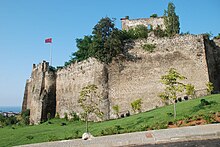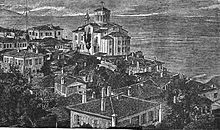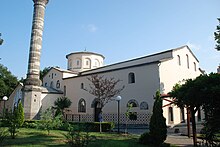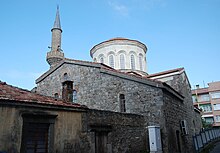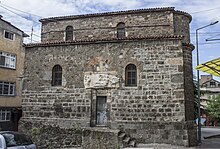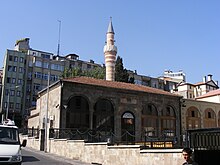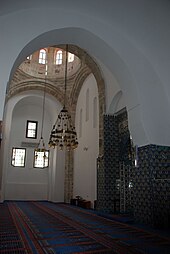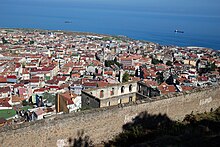Trabzon
| Trabzon | ||||
|
||||
 Harbor basin from Boztepe Hill |
||||
| Basic data | ||||
|---|---|---|---|---|
| Province (il) : | Trabzon | |||
| Coordinates : | 41 ° 0 ' N , 39 ° 44' E | |||
| Height : | 39 m | |||
| Surface: | 4,685 km² | |||
| Residents : | 807.903 (2019) | |||
| Population density : | 172 inhabitants per km² | |||
| Telephone code : | (+90) 462 | |||
| Postal code : | 61000 | |||
| License plate : | 61 | |||
| Structure and administration (as of 2019) | ||||
| Mayor : | Murat Zorluoğlu ( AKP ) | |||
| Website: | ||||
Trabzon , German historical Trebizond ( Greek Τραπεζούντα, in antiquity Trapezus , English historical Trebizond ), is a city in northeastern Turkey and its easternmost major port on the Black Sea . In 2019, the city of Trabzon has a total of 807,903 inhabitants, and the city center of Ortahisar has 328,457 inhabitants. The metropolitan commune is identical in area to the province of the same name . The city is also a trading center for the export of hazelnuts , tea and tobacco grown in the surrounding area .
The ancient name of the city was Τραπεζοῦς Trapezous , accusative Τραπεζούντα Trapezounta , from which the Latin name Trapezunt (um) is derived. Around the 7th century BC Founded by Greek settlers in the early 2nd century BC, the Roman Emperor Hadrian built an artificial harbor and expanded the city. The trading post on the Silk Road , which was busy in the Middle Ages and up to the First World War , belonged to the Trapezunt Empire from 1204 to 1461 , when the Comnen dynasty ruled. During this time, the Byzantine cathedral Hagia Sophia and almost all other historically significant buildings were built. Most of the churches were converted into mosques during the Ottoman period.
Location and traffic
The E 70 , which runs along the coast, connects Trabzon with the large port cities of Samsun in the west and Batumi across the border in Georgia. The nearest medium-sized towns are Giresun , 134 kilometers to the west, and Rize , 76 kilometers to the east. The E 97 branches off to the south, which leads through a valley in the Eastern Pontic Mountains to Erzurum and Erzincan . The old mountain road crossed the 2032 meter high Zigana Pass , the new road shortens the pass height a little to the west through a tunnel. The Değirmendere flowing in this valley flows into the sea to the east of Trabzon. The mountains with peaks up to over 3000 meters high separate the coastal strip, which is only a few kilometers narrow, from the inner Anatolian highlands .
Trabzon is not connected to the Turkish rail network. The Türkiye Cumhuriyeti Devlet Demiryolları (TCDD) is planning a high-speed line for 200 km / h, which should go into operation before 2023. The planning envisages the route Erzincan- Bayburt - Çaykara - Of -Trabzon and a 35 kilometer long tunnel through the mountains between Bayburt and Caykara.
Trabzon International Airport is eight kilometers east of the center on the Black Sea coast.
The port is divided into a commercial port, a fishing port, a passenger port and a marina . There is a ferry connection with Sochi in Russia. The Turkish Navy also operates a base in Trabzon .
history
Pre-Greek time
From the time before the Greek colonization in the 8./7. Nearly nothing is known about Trabzon in the BC century. From the inland, the coast near Trabzon with the coastal plain, which is only a few kilometers wide, is sealed off by the Eastern Pontic Mountains running parallel to the coast and can only be reached via the Zigana Pass , which is over 2000 m high , so that there is a lack of interest in the prehistoric cultures of Anatolia, Syria and Mesopotamia with written records the area is not surprising. There are no written sources about Trabzon or an earlier settlement at this point.
Antiquity
According to Greek tradition, Trapezus was born in 756 BC. Founded according to Xenophon by settlers from Sinope , a colony of Milets . Different founding dates have been passed down for Sinope itself, although the archaeological findings that Greek settlement began in the late 7th century BC. BC, best with the founding date 631 BC. BC of Eusebius are compatible. According to this, Trabzon can only be found in the late 7th or 6th century BC. Be settled by Greeks from Sinope. These colonies on the Black Sea were small enclaves of Greek culture, whose domain extended only a little inland. According to the Greek historian Herodotus , the Kimmerians conquered around 700 BC. Chr. U. a. also the coastal region around Trapezus. From here they undertook raids into Asia Minor until they were repulsed by the new Assyrian ruler Assurbanipal (ruled 669-627). Around 546 BC The Achaemenid king Cyrus II conquered the eastern Black Sea region, which was declared a Persian satrapy . Intrigues about the succession to the throne led to a dispute between Artaxerxes II and his brother Cyrus , who lived in 401 BC. In the battle of Kunaxa (about 80 kilometers north of Babylon on the Euphrates ) ended with the death of Cyrus. The more than ten thousand Greek mercenaries fighting in the army of Cyrus and their slaves under the leadership of Xenophon retreated north, crossed the satrapy of Armenia and finally reached the port of Trapezos. The "train of ten thousand" is described in Xenophon's writing Anabasis . In Trapezos the old and injured were transported on ships, the remaining mercenaries marched via Pergamon to their homeland. Xenophon mentions the city in his Anabasis as paying tribute to neighboring Sinop.
After his victory over the Persians in the battle of Issus in 333 BC. In BC Alexander the Great also conquered the eastern Black Sea coast. After his death in 323 BC BC founded Mithridates I in 301 BC in the north of the Seleucid Empire in Asia Minor . The kingdom of Pontus with Trapezus as the most important port. Up to Mithridates VI. Eupator (r. 120–63 BC) had expanded the Pontic Empire to the maximum and threatened the provinces of the Roman Empire in western Asia Minor. In three Mithridatic Wars , the Romans defeated the Pontic Empire. By the end of the first century AD, the entire Black Sea coast was gradually incorporated into the Roman Empire as provinces.
During the Roman Empire, Hadrian (r. 117-138) had Trapezus expanded to become the provincial capital, which made a name for itself as a shipbuilding center with its artificial port in 129 AD. The port was now the end of a military road that led to the border on the Syrian Euphrates . The Romans also had the upper citadel and the central part of the city fortifications built or reinforced.
Late antiquity to the early Middle Ages
In 256 AD, attacking Goths destroyed Trapezus, which hardly recovered economically, although it was finally the seat of a governor until the 4th century and the quarters of the Legio I Pontica since the end of the 3rd century . The Christian residents built many churches and monasteries in the early Byzantine period. In the 6th century, Emperor Justinian I had the city walls reinforced. Building remains from the following centuries - with the exception of St. Anne's Church from 884/885 - have not been preserved, but the city must have remained an important port; from the 9th century it was the main place of the Chaldia theme . Trebizond experienced a heyday under Emperor Basil II (r. 976-1025). He had numerous churches built, which have either disappeared today or whose original structures have been built over. During the rule of the Iberian Bagratids (820-1000) Trabzon maintained a lively trade with Georgia, which was settled via Ardanuç and the valley of Kola.
middle Ages
Around the mid-1080s, the military under Theodoros Gabras succeeded in recapturing Trebizond, annexed by the Seljuks, for Byzantium and establishing itself as a de facto independent ruler on the Pontic Black Sea coast. It was not until 1140 that Emperor John II restored imperial authority in Trebizond.
When the armies of the Fourth Crusade unexpectedly attacked the Byzantine Empire in 1204 , overthrew it and established the Latin Empire in the conquered Constantinople , several Byzantine successor states emerged around it. The empire of Trebizond was one of them, although it was founded in April 1204, before the fall of Constantinople. Trebizond became the capital of a separate empire, a branch of the Byzantine ruling dynasty of the Comnenes that had fled from the popular uprising as early as 1185 . The two grandsons of Emperor Andronikos I , Alexios and David Komnenos, had found support at the court of Queen Tamar of Georgia . Alexios I became the first Emperor of Trebizond in 1204, his younger brother David moved westward and conquered Sinop , but ultimately failed in western Asia Minor at the Nikaia Empire . The Genoese had had a colony in Trebizond since 1204, in Amisos (today Samsun ) since 1289 and in Sinop in 1301. The rival Venetians opened a trading post in Trebizond in 1319.
After the Mongol invasion in the middle of the 13th century, the city experienced enormous prosperity through trade and customs duties. It became the hub of trade routes to Russia , the Mediterranean and the Middle East . The Venetian merchants' quarter played an important role, especially since the Venetians had been ousted from the Crimea by the Genoese . In the course of this economic and cultural boom, magnificent buildings such as the Hagia Sophia church were built in the capital . With the decline of Mongolian power after 1320, Trebizond also found itself increasingly exposed to attacks by Turkish tribes. There were also civil wars and internal intrigues. Nevertheless, the city retained its status as an important trading center on the Black Sea well into the 15th century.
At the height of its power, the Komnenen court was an important artistic and cultural center that made Trebizond the last refuge of Greek culture in Asia Minor . During this time most of the churches that can still be seen today were built. The Komnenen also promoted the construction of new monasteries and supported the expansion of existing monasteries. In the second half of the 14th century, numerous Armenian immigrants came who had fled the declining city of Ani or from years of fighting in the area around Sivas . The most important Armenian building from this period is the Kaymaklı Monastery on Boztepe Hill three kilometers southeast of the city center.
After the conquest of Constantinople by the Turks in 1453, the empire of Trebizond maintained itself under Ottoman rule for a few years . Trebizond finally fell to Mehmed II under the last Grand Comnenus, David Komnenos, in 1461 , after it had made one last attempt to restore the Byzantine Empire as the leader of an alliance of Greek lands against the Sultan. David was taken to Constantinople and strangled there with his family. Mehmed had the wealthy part of the population resettled to Constantinople, others were assigned to the army as slaves, and 800 young men ended up in the Janissary Corps . The poor population living in the port area remained in Trebizond. The military moved into the upper fortress and the fortified middle city. In Ottoman times, the Eyâlet Trabosan was formed from the Empire of Trebizond . Up until the 19th century hardly any new buildings were erected, instead of building mosques, the existing churches were converted.
19th century
At the beginning of the 19th century, trade with Russia made Trabzon economically strong and partly independent of the Ottoman government, which did not collect taxes from the city's citizens. In the Russo-Turkish War of 1828–1829, Russian units advanced to Trabzon. In the Treaty of Adrianople , signed after the end of the war, Russia secured its previous trade privileges for the entire Ottoman Empire. Subsequently, other European powers demanded similar guarantees for their trade in the coastal cities on the Black Sea. Sales in the port cities rose by leaps and bounds, but most of the profit went abroad. From 1829 several foreign consulates opened in Trabzon, until the mid-19th century British companies dominated the city's economy through their transit trade with Persia. The Crimean War of 1853–1856 still promoted trade because military equipment was now also being loaded at the port. From the middle of the 19th century, new, but not very significant church buildings were built for the first time since the Middle Ages, in which services were held until 1923.
In 1836 a British shipping company opened a steamship line from Istanbul via Samsun to Trabzon; companies from four other countries followed a few years later. This shipping route also had a beneficial effect on the long-standing trade in Circassian and Georgian slaves, who were brought via the port of Trabzon, preferably on British ships to Istanbul, the Levant and Egypt . Under pressure from European countries, the slave trade was officially banned in 1855, which is why traders now transported slaves from the Caucasus in smaller sailing boats on the stormy eastern Black Sea to Trabzon, where they were smuggled on in various ways. Slavers were still in the city in the early 1870s. The trade in goods to Persia declined with the opening of the Suez Canal in 1869 and the subsequent opening of the Iranian port of Khorramshahr . With the construction of railway lines across Anatolia at the beginning of the 20th century, Trapezunt fell further into the traffic-technical offside.
20th century
In February 1914 the commission for the “patriotic collection” for the purchase of warships was given to criminals by the city committee for unity and progress . The Greeks and Armenians of Trebizond were blackmailed, shops plundered (see also Persecution of the Greeks in the Ottoman Empire 1914–1923 ). As in other cities, a boycott of Armenian and Greek companies followed. Shortly after the general mobilization, the Armenian high school fell victim to a fire. After Bahattin Şakir's visit on June 23, 1915, the Red Cross Hospital was closed and the deportation of the Armenian population began in the wake of the genocide of the Armenians . Many Armenian women and children were driven out into the open sea in boats on the orders of the Vilayet governor Cemal Azmi (also known as the "butcher of Trebizond"), where they capsized. The American consul in Trebizond reported that boats were fully loaded and returned empty hours later.
During the First World War , the Turks left the city in April 1916. The Greek population informed the Russian troops that occupied Trebizond on April 19, 1916 and then stopped the advance along the sea coast. Some Greek church leaders and business people cooperated with the Russians, thus drawing the aversion of the Turkish majority. From January 1918, however, the Russians withdrew after negotiations. Turkish militias immediately began attacking the Greek community, which was barricading itself in parts of the city. On February 14, 1918, a troop of Turkish soldiers arrived, they were unable to restore peace and order in the power vacuum. The security situation deteriorated over the next two years. A Greek independence movement seeking an independent Pontic republic between Samsun and Trabzon reinforced its demand on New Year's Day in 1920 with a series of bombings. The Treaty of Sèvres initially envisaged Trebizond as part of Armenia . However, in April 1920, the Turkish army took control of the city.
After the defeat of Greece in the Greco-Turkish War of 1919–1922, the large proportion of the Pontic Greeks were resettled to Greece as part of the “ population exchange ” agreed in the Treaty of Lausanne . In contrast, the Greeks who converted to Islam stayed behind in Trabzon.
A US military base existed from 1953 to 1970. Since the opening of the former Soviet republics to the west after 1991, mainly Russian tourists and traders have been traveling to Trabzon. A distinctive infrastructure was created for the visitors.
In 2013, the German Armed Forces set up the Trabzon logistics transhipment point in the port of Trabzon , through which material from Afghanistan was returned to Germany until December 2014 .
Cityscape
The city's name is derived from the Greek trapeza , "table" or "flat plane", and refers to the shape of the citadel hill that towers over the city to the west of the port. The fast-growing suburban settlements along the coast have built over a large part of the former agricultural areas right into the steep mountain slopes. The port lies roughly in the middle of the built-up urban area that extends along the coast. South of the port, behind the narrow foreshore, the steep ascent to the local mountain Boztepe begins. The business center extends from around 200 meters west of the harbor basin behind a foothill by the sea, which the coastal motorway crosses in a tunnel. This is oriented towards the Ataturk Alanı , a central, rectangular square, which is also called Meydan Parkı and is dominated by the statue of the state's founder Ataturk . In the vicinity of the square, a large number of hotels in all price ranges, restaurants, boutiques and shops are lined up on the main and side streets.
Along the coastal road to the east, there is an extensive industrial area around the port facilities. A pedestrian zone ( Uzun Sokak ) and several parallel streets lead from Ataturk Alanı to the west through compact residential areas to the fortress hill one kilometer away. The archaeological-ethnographic Trabzon Museum, built around 1900 as the home of a Greek banker, is located on Zeytinlik Caddesi , which goes south from Uzun Sok .
The Technical University Karadeniz Teknik Üniversitesi near the airport was founded in 1955. The Greek Phrontisterion of Trebizond , founded in 1682, lasted until 1921.
Fortress hill
Kule Hisar
The entire fortress is divided into three areas, the “lower fortress” ( Aşaği Hisar ), “middle fortress” ( Orta Hisar ) and “upper fortress” ( Kule Hisar , or “inner fortress” ) along a narrow ridge of hills directed inland from the coast “, Iç Kale ). During a civil war in the 17th century, the upper fortress, which tapered to the south, was destroyed; the Ottoman governor previously resided here. The fortress wall rebuilt under Alexios II (r. 1297-1330) was preserved in its western part, which rises on the edge of the rock above a deeply cut transverse valley. According to an inscription, it was completed in 1324. At the place of the upper castle (citadel) today a modern residential area with multi-storey new buildings extends far up the slope. The preserved structures of the citadel date from the time of the Trapezunt Empire. In a few places the overbuilt, older surrounding wall of the Roman Acropolis from the end of the 1st or 2nd century AD can still be seen. Back then, large, carefully hewn stones were stacked on top of one another without mortar.
Orta Hisar
The entire hill is crossed by a road ( Iç Kale Caddesi ) in a north-south direction . The surrounding walls of the central fortress probably date mainly from the Middle Byzantine period. Two road bridges lead into this partly historical area: from the east the Tabakhane Köprüsü from the 19th century and from the west the Zağnos Köprüsü (also Zağanos Paşa Köprüsü ). It was named after one of the first provincial governors ( Beylerbey ) of the Eyâlet Trabzon. The bridge today consists of a single massive round arch, forerunners existed in the Roman or Hellenistic times. Parts of two of the possibly eight arches of the Roman bridge can still be seen a little south on the western bank of the stream.
The Orta Hisar Camii , also known as Fatih Camii , is located in the middle fortress. The mosque is the former cathedral Panaghia Chrysokephalos (" Gold- headed Mother of God"), named after an icon of Mary that was kept in the church and had a golden halo . According to the historical tradition, Hannibalianus , the nephew of Constantine the Great, had the first St. Mary's Church built on the site of a temple at the beginning of the 4th century. In the 10th century there was a bishop's church here, which was completely rebuilt at the beginning of the 13th century. After the renovation, the cathedral was a simple three-aisled pillar basilica with galleries above the side aisles, which served as the coronation church of the empire. On the east wall protruded an apse , pentagonal on the outside and circular on the inside , which was illuminated by three windows. The west wall of the nave was preceded by a narthex , which is still there today. After Emperor Andronikos I (r. 1222–1235) survived a siege of the city by the Rum Seljuks in 1228 and concluded a treaty on the independence of Trapezunts with them, he left the Church of the Golden-Headed Mary as thanks for divine salvation decorate magnificently. The apse was clad with marble and the apse floor was covered with mosaics. The mosaic floor is now hidden under wooden boards with a carpet, while smaller restored fields with marble mosaics have been preserved on the walls.
It was probably converted into a cross-domed church between 1339 and 1351. The second pair of pillars was removed in order to create a square space between four mighty pillars in front of the chancel. A twelve-sided drum , connected by means of pendants , was built over this basic shape and covered with a dome. The side rooms in the north and south, which were converted into transepts, received high vaulted ceilings. Presumably, vestibules were built on both sides, another narthex with barrel vaults in the west (exonarthex) was supposed to restore the strong longitudinal orientation on the altar that was lost through the installation of the transept. Its four transverse ribs are in alignment with the pillars of the inner narthex. The semicircular side apse in the south of the east wall was a smaller extension from this period. Shortly after the Ottomans took Trebizond in 1461, the church was rededicated in 1468 as a mosque, and the southern transverse structure disappeared. The straightened south wall was given a mihrāb . Under the white painted walls, at least parts of the old frescoes should have been preserved.
A few meters north, directly on the north wall of the central fortress town, is the Çifte Hamam ("double hamam "), which was originally also a church, probably a basilica with a dome and three apses. In today's steam bath, the men use the former nave and the narthex, the women use the apses and chancel. Only part of the west and south-east walls can be seen from the outside.
Aşaği Hisar
While the middle and upper fortress town was bounded in the west by the steep valley cut, the lower fortified district, laid out at the beginning of the 14th century, included this valley. In the north, the walls reached directly to the coast, where previously the port built under Hadrian was. At that time, the port had already been relocated to its current location on the headland 1.5 kilometers east. Most of the wall remains that have been preserved are built in by houses. The surrounding walls were not particularly secured, there were no defensive towers, only open wall projections in a few places at the rear.
The Nakıp Camii in the lower fortress city was considered one in 10/11. The basilica, built in the 19th century, is dedicated to the apostle Andrew , who is said to have proselytized in Trabzon. Presumably shortly after the Ottoman conquest, it was converted into a mosque and given a porch along the north side. A central and northern, horseshoe-shaped apse protruded from the east wall. The building was abandoned around 1960, when a narthex was still visible on the west side. The building has been restored since 2019.
Yeni Cuma Camii
The “New Friday Mosque” is the converted church of a monastery that has been called St. Eugenios since the 9th century and stands about 150 meters east of the citadel. Basil II ordered the construction of the first Eugenioskirche during his stay in Trabzon at the turn of the year 1021/22. At the beginning of the Comnenen rule, Eugenios had become the main saint of the city. According to legend, the Christian martyr is said to have stormed the Mithras temple around 300 on Mount Minthrios (today Boztepe, three kilometers southeast of the city) with allies and was beheaded for it.
At the end of the 13th century a new and larger church was built a little to the north. The stone floor, which is covered today, dates back to the year 1291 like the basilical plan. Both churches were in flames during a civil war in 1340, shortly afterwards under Emperor Alexios III. (r. 1349–1390) repaired the northern church in a new form and converted it into a mosque early on. In 1461, after conquering the city, Sultan Mehmed II performed his first Friday prayer here and ordered the construction of a minaret.
The building that has been preserved is a cross-domed church, from whose rectangular shape a large pentagonal and two smaller round apses protrude on the east side in the middle. A tall, windowed drum with a dome rises above the central square. The arches on the east side of the square rest on cruciform pillars, while, unusually, two Doric columns have been reused on the west side . The white paint hides 14th century frescoes. The west portal is walled up, a residential building adjoins it, access is through a porch on the north side next to the minaret. The building was thoroughly renovated in the years after 2000.
St. Anne's Church
The small Byzantine Church of St. Anne (Greek Hagia Anna , Turkish Küçük Ayvasıl Kilise ) is the city's oldest surviving church. The three-aisled basilica is located in a lively business district about 200 meters east of the central fortress city. According to an inscription above the south portal, the roughly joined outer wall was restored or rebuilt in 884/85 under the Byzantine emperor Basil I. The inside of the prayer room measures 6.6 meters in width and 7.4 meters in length. To the east there are three horseshoe-shaped apses protruding from the gable wall, the middle one is slightly larger and is lit by three windows, the side apses by one each. A re-used pair of columns with Ionic capitals carry girders in both directions. The middle barrel vault is about 2.5 times as high as the pillars, the narrower side vaults are only slightly lower. Access is via a staircase from the south side.
St. Anne's Church is the only one to have a crypt , and it is believed to have served as a burial chapel from the 13th century. It was not later rededicated into a mosque. The building is in fair condition after a restoration in the 1970s or 1980s, the interior has been cleared and is usually locked.
Further buildings in the center to the east
The large Armenian St. Basil Church ( Büyük Ayvasil Kilise ) was preserved a few meters north of St. Anne's Church, it probably dates (after a renovation?) From the 14th or 15th century. From this time it has a cross dome within a rectangular nave, which between 1890 and 1895 was extended by a column to the west. In addition, a narthex was built in front of the west wall. The columns in the nave are spoils from a late Roman building. A gallery above the narthex continues in a U-shape on the north and south walls into the main room. The entrance is in the south wall of the narthex.
The Church G from the 19th century stands north of Meras Avenue, and is similar in ground plan of St. Basil's Church. The domed tambour is connected to the central square of belt arches via pendants, to which barrel vaults connect across the side aisles across the vaults of the main room. The walls of the drum are twelve-sided on the outside and partially rest on the vaults that extend from the belt arches. The three apses on the east wall are connected by narrow doors. In the western narthex a staircase leads to the gallery. Originally there were two entrances on the west wall of the narthex, of which the southern one was walled up. At the north entrance a three-story, open bell tower is built, the first floor of which consists of two columns and two pilasters on the west wall of the narthex, which are connected by round arches. The middle floor is at the level of the gallery and is accessible from there. A dome covers the octagonal upper floor.
About 250 meters to the east was the large Greek Orthodox monastery church , consecrated to Gregory of Nyssa , probably founded by Eudokia Palaiologina (around 1265–1301), the wife of the Great Lord John II. Monks still lived in the monastery at the beginning of the 17th century. After 1665 - the previous St. Philip's Cathedral was converted to the Kudrettin Mosque - St. Gregory served as a cathedral. In 1863 (1866) the cathedral was rebuilt and kept its function until 1923. Before 1943 the building was destroyed.
The İskender Paşa Camii is located near the town hall ( Trabzon Belediye east) of the Church G on Taksim Square. The rectangular, domed mosque was built in the 16th century by İskender Paşa, a pasha of Trabzon- Eyâlet . Alterations and extensions took place in the 17th century and in 1883, when the portico, which serves as an extended prayer room ( son cemaat yeri ), was added to the north wall.
West of the citadel
The most important building in the city is the Hagia Sophia (today Aya Sofya Müzesi ) three kilometers from the center in a western outskirts. The monastery church was built under Emperor Manuel I (r. 1238–1263) and converted into a mosque in the 16th century. Construction of the bell tower began in 1426 during the reign of Emperor Alexios IV (ruled 1417–1429), it was completed under his successor John IV (ruled 1429–1459). In 1880 a devout Muslim had the magnificent wall paintings whitewashed, and they were restored in the middle of the 20th century. In mid-2013, the previous museum was used as a mosque again for the first time.

The Gülbahar Hatun Camii , also Hatuniye Camii or Büyük İmaret Camii , is a mosque built before 1515 on the west side of the valley opposite the central fortress city. It was built for Gülbahar Hatun, the wife of Sultan Bayezid II (ruled 1481–1512) and mother of Sultan Selim I (ruled 1512–1520). Her birth name in Greek was Maria. In 1468, Crown Prince Bayezid married the princess from Trabzon, who was later given the nickname Gülbahar ("spring rose") for her good deeds . The mosque is a square structure with a central dome over a twelve-sided drum. Two smaller domed rooms are attached to the northern end of the east and west walls. An entrance porch with a wide roof was added in front of the north wall, which was extended in this way. A series of five domes over octagonal drums structure the roof of the vestibule.
In the courtyard to the east of the mosque is the Türbe , dated 1505/06 , in which Gülbahar Hatun is buried. The octagonal building has a two-tier roof, which is formed by the attached tambour with its dome. The door and all windows are accentuated by a pointed arch made of black and white stone blocks over a blind niche. Inside, the transition from the dome to the walls is through simple arched fields.
About 200 meters to the north, near the coast, is the Küçük Fatih Camii , a church building dated around the 12th century, which was originally dedicated to Saint Akindinos and was later converted into a mosque and supplemented by a minaret. The polygonal apse of the single-nave church and parts of the east wall were rebuilt at the time of the Trapezunter Empire, and an extension with a gable roof was added in the north.
A few meters further to the coast is the church for John the Baptist Exoteicho ("without / outside the walls") from 1856 ( church H ). A church from 1306 at this point was demolished for the new building. The cross-shaped complex within a rectangular plan is similar to Church G and has a narthex on the west side, which is accessible from the west. Behind the entrance a staircase leads to the gallery. The dome covers an octagonal drum. In 1966 the building served as a storage room. In 1884 the Church Library owned a 14th-century Greek manuscript that has been in the collection of the University of Chicago since 1929 .
Between the port and Boztepe
The Kudrettin Camii in an old town quarter directly above the harbor basin was built as the church of St. Phillip in the 14th century (around 1300). She is said to be from Anna, daughter of Emperor Alexios III. (ruled 1349–1390). The small domed building has a single nave church interior with a polygonal apse on the outside due to a later extension to the west. The tambour is twelve-sided on the outside and bright inside thanks to large windows. From the Ottoman conquest in 1461, the Phillipskirche functioned as a cathedral, which is probably why the expansion was necessary. In 1665 it was converted into a mosque, with the original entrance in the south and the vestibule in the west walled up and a new entrance with vestibule created in the north.
The Sabas cave churches (Turkish Maşatlık Mağaraları ) are not accessible. The cave churches are located on the steep slope of Boztepe, southeast of the Kudrettin Camii. The eastern cave chapel was painted in 1411, the two in the west probably in the second half of the 13th century. In the main church, which is dated to the first half of the 15th century, frescoes with biblical scenes from the same period are partially still well preserved.
Three kilometers from the center, on the eastern slope of Boztepe, the ruins of the Armenian monastery Kaymaklı have been preserved. The Turkish name Kaymaklı Manastırı ("Cream Monastery") is due to the so-called milk fountain, which is said to have existed next to the main church. Armenian monks lived here until 1915. Several caves served as monks' quarters, others as chapels.
The Greek nunnery Panaghia Theoskepastos (the Mother of God protected by God, Turkish Kızlar Manastırı, "girls' monastery ") on the northwest slope of Boztepe was set up on the site of a Mithras cult cave ( Mithräum ). The cave was used as a church in the early Byzantine period and still contains remains of frescoes in the apse. Under Alexios III. Princess Irene Komnena re-founded the monastery. Emperor Manuel III (reigned 1390–1417) and his son Andronikos are buried here, the latter's tomb has been preserved under one roof, the other tombs, like the ruins of the building, date from the 19th century. Greek nuns lived in the monastery until 1923. The outer walls preserved up to the edge of the roof can be seen from above from the picnic area on Boztepe.
Sports
Trabzon is home to the internationally important football club Trabzonspor . The team has so far celebrated six championships and won the Turkish Cup eight times . Trabzonspor is one of the four most successful teams in Turkey .
sons and daughters of the town
- Muhammed Altıntaş (born 1964), football player
- Ömür Arpacı (* 1982), actor
- Ömer Asan (* 1961), folklorist, photographer and author
- Athanasios Athonitis (around 925 - around 1000), monk and founder of a monastery
- Selçuk Aydın (* 1983), boxer
- Erdoğan Bayraktar (* 1948), politician
- Bessarion (1403–1472), Byzantine theologian and humanist
- Tayfun Cora (* 1983), soccer player
- Hüseyin Çimşir (* 1979), football player
- Mustafa Demir (* 1961), politician
- Gökhan Durmuş (* 1987), football player
- Uğur Erdener (* 1950), ophthalmologist and sports official
- Yaşar Nezih Eyüboğlu (* 1962), stage actor
- Ignazio Ghiurekian (1833–1921) Armenian Catholic religious, Abbot General of the Mechitarists of Venice
- Şenol Güneş (* 1952), football player and coach
- Olcay Gür (* 1991), Liechtenstein soccer player of Turkish descent
- Hemaiag Bedros XVII. Guedikian (1905–1998), Patriarch of Cilicia
- John VIII Xiphilinus (around 1010–1075), Patriarch of Constantinople
- Tugay Kerimoğlu (* 1970), football player
- Barış Memiş (* 1990), football player
- Faruk Nafız Özak (* 1946), civil engineer and minister
- Dimitrios Partsalidis (1905–1980), Greek politician
- Ioannis Pasalidis (1889–1968), Greek politician
- Muhammet Reis (* 1984), football player
- Oktay Rifat (1914–1988), lawyer and writer
- Fuat Saka (* 1952), musician
- Suleyman I the Magnificent (around 1495–1565), Ottoman Sultan
- Cevdet Sunay (1899–1982), general and former president
- Leon Surmelian (1905-1995), American writer
- Fatih Tekke (* 1977), football player
- Haig Tiriakian (1871–1915), Armenian publisher
- Nihat Tosun (* 1959), Deputy Minister of Health
- Sali Turan (* 1949), painter
- Mehmet Cahit Turhan (* 1960), politician
- Bahriye Üçok (1919–1990), humanities scholar, journalist and politician
- Haluk Ulusoy (* 1958), former chairman of the Turkish Football Association
- Cemil Usta (1951-2003), football player
- Huysuz Virjin (* 1932), travesty artist
- Burak Yeter (* 1982), producer and DJ
- Güngör Yilmaz (* 1961), German politician (Greens)
Twin cities
Trabzon maintains partnership relationships with
-
 Sochi , Russia (1993)
Sochi , Russia (1993) -
 Rizhao , PR China (1997)
Rizhao , PR China (1997) -
 Szigetvár , Hungary (1998)
Szigetvár , Hungary (1998) -
 Batumi , Georgia (2000)
Batumi , Georgia (2000) -
 Rascht , Iran (2000)
Rascht , Iran (2000) -
 Zanjan , Iran (2001)
Zanjan , Iran (2001) -
 Dortmund , Germany (2009)
Dortmund , Germany (2009)
Climate table
| Trabzon, Ortahisar (39 m) | ||||||||||||||||||||||||||||||||||||||||||||||||
|---|---|---|---|---|---|---|---|---|---|---|---|---|---|---|---|---|---|---|---|---|---|---|---|---|---|---|---|---|---|---|---|---|---|---|---|---|---|---|---|---|---|---|---|---|---|---|---|---|
| Climate diagram | ||||||||||||||||||||||||||||||||||||||||||||||||
| ||||||||||||||||||||||||||||||||||||||||||||||||
|
Monthly average temperatures and precipitation for Trabzon, Ortahisar (39 m)
|
||||||||||||||||||||||||||||||||||||||||||||||||||||||||||||||||||||||||||||||||||||||||||||||||||||||||||||||||||||||||||||||||||||||||||||||||||||||
literature
- Volker Eid : East Turkey. Peoples and cultures between Taurus and Ararat . DuMont, Cologne 1990, ISBN 3-7701-1455-8 , pp. 129-141.
- Michael Richard Thomas Dumper, Bruce E. Stanley, Janet L. Abu-Lughod: Cities of the Middle East and North Africa: a historical encyclopedia. ABC-Clio, Santa Barbara (Ca) 2006, pp. 360-366
- Vera and Hellmut Hell: Turkey. Northern Turkey, Eastern Turkey, Southeast Turkey. Kohlhammer, Stuttgart a. a., 3rd ed. 1988, pp. 55-67
- Thomas Alexander Sinclair: Eastern Turkey. An Architectural and Archaeological Survey. Vol. II. The Pindar Press, London 1989, pp. 48-82
Web links
Individual evidence
- ↑ Nufusu.com
- ↑ Istanbul-Trabzon route seven hours by train. Detay Haber, 2006
- ↑ Xenophon, Anabasis 8.4
- ↑ Ekrem Akurgal - Ludwig Budde : Preliminary report on the excavations in Sinope. Türk Tarih Kurumu Basımevi, Ankara 1956.
- ^ Dumper / Stanley / Lughod, p. 360
- ↑ Xenophon : Anabasis , 5.5.7
- ↑ Herwig Wolfram : The Goths. 4th edition Munich 2001, p. 59.
- ^ Robert W. Edwards: The Vale of Kola: A Final Preliminary Report on the Marchlands of Northeast Turkey. Dumbarton Oaks Papers 42, 1988, p. 126
- ^ Sinclair, p. 50
- ↑ Hell, pp. 57f; Sinclair, 50f
- ^ Dumper, Stanley, Abu-Lughod, p. 364
- ^ Raymond Kévorkian : Le Génocide des Arméniens. Odile Jacob, Paris 2006, p. 585
- ^ Raymond Kévorkian: Le Génocide des Arméniens. Odile Jacob, Paris 2006, p. 589
- ↑ Tragedy of Failures. Unsuccessful victories , Aleksandr Gennadjewitsch Bolnych
- ^ Dumper, Stanley, Abu-Lughod, p. 365
- ↑ This is what moves the Bundeswehr - the greatest logistical feat of strength mastered. News Current press portal, December 5, 2014
- ↑ Hell, p. 59
- ↑ Sinclair, pp. 68-70, Eid, pp. 132f
- ↑ Sinclair, pp. 70f
- ↑ 2105686: St. Andreas Church, Nakip Camii. Trabzon (province). IDAI, University of Cologne (pictures of the ruin)
- ^ Sinclair, p. 72, Eid, p. 133
- ↑ policy Güğüm 20-04-2019 . 61Saat, April 20, 2019 (picture of the restored building)
- ↑ Eid, p. 134; according to Hell, p. 59: at the time of Trajan (r. 98–117)
- ↑ Sinclair, pp. 72-74; Eid, p. 134f; Heath W. Lowry: Trabzon's Yeni Cuma Camii (New Friday Mosque): What ist it called what it is? (PDF; 385 kB) Bogazici Üniversitesi Dergisi, Vol. 3, 1975, pp. 91-102
- ↑ Selina Ballance: The Byzantine Churches of Trebizond. In: Anatolian Studies , 10, 1960, pp. 141–175, here pp. 154f
- ↑ Sinclair, 74; Eid, p. 134; Hell, p. 59
- ^ Sinclair, p. 75
- ^ Sinclair, p. 76
- ^ Anthony Bryer: Byzantine Monuments and Topography of the Pontos. Dumbarton Oaks Studies, Washington DC 1985, p. 205, ISBN 978-0-88402-122-3
- ↑ Anthony Bryer: Some Trapezuntine Monastic Obits (1368-1563). In: Revue des études byzantines. No. 34, 1976, pp. 125-138, here: p. 129
- ^ Sinclair, p. 80
- ↑ Sinclair, pp. 63f; Oath, p. 136f
- ^ Sinclair, p. 64
- ↑ Ms. 137, New Testament. Gospels (Isaac Gospels). Greg. 2399. Trabzon, Turkey (Trebizond)? 14th century. The University of Chicago Library
- ^ Oath, p. 135
- ^ Sinclair, pp. 77f
- ^ Sinclair, p. 79
- ↑ Oath, p. 136
- ↑ Panaghia Theoskepastos photo from virtualtourist.com
- ↑ Sinclair, pp. 78f; Oath, p. 135
- ↑ Süper Lig - Successes: all champions at a glance. Retrieved April 30, 2019 .



